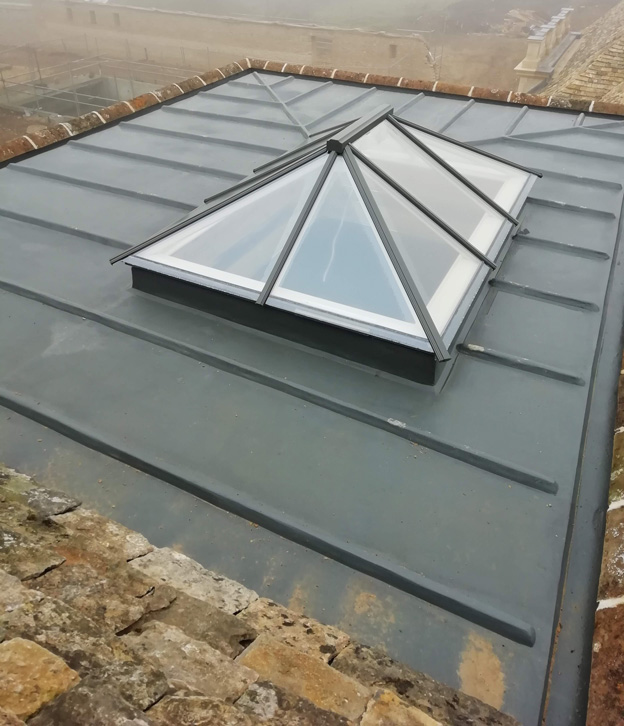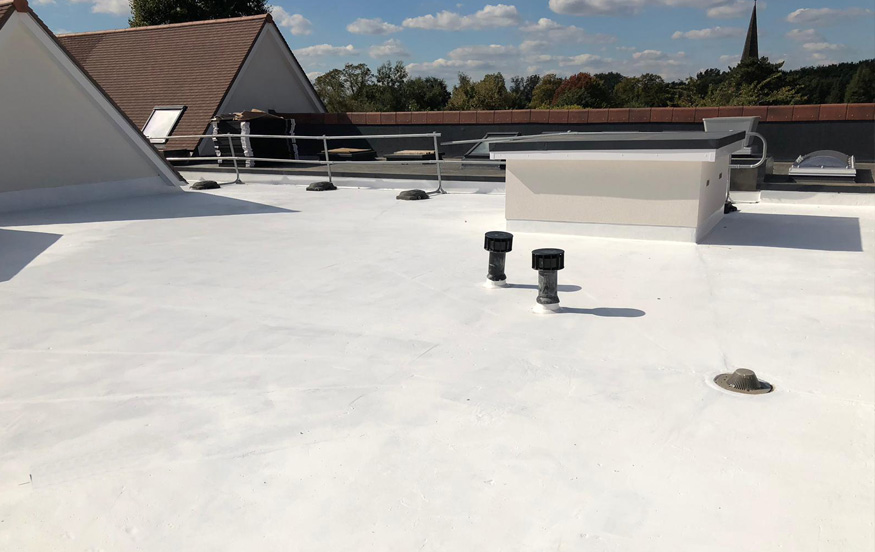Although mastic asphalt is one of the world’s most traditional roofing materials, it can sometimes be wrongly perceived by specifiers and clients as a one-dimensional waterproofing product that is only available in a standard black finish. But like many long-lasting, tried and tested materials, mastic asphalt is being re-imagined, modified and re-examined as a highly relevant building material for today.
At the Mastic Asphalt Council (MAC), we have noted an increase in roofing projects whereby mastic asphalt is specified with a requirement for the finished product to have a different appearance to the norm.
Oxford Asphalt, a member of the Mastic Asphalt Council (MAC) for over 20 years, has carried out a roofing project at a private residence near Witney in Oxfordshire whereby the architect concerned was seeking a roofing material that had the general appearance of lead, but with a seamless finish. Metal theft is one of the fastest growing crimes in the UK and both the architect and building owner wanted to avoid the prospect of lead being stolen from the roof.
A seam-free system would ensure that there was no threat of water penetration through any joints, laps or seams and it would also ensure that the roofing system could be easily spot repaired if need be, eliminating the need for costly wholesale replacement. The main contractor for the project was Midland Builders.
 Terry Grandi, Director of Oxford Asphalt said: “This project was different to the norm as the client wanted the roof to look like lead and have the seamless look of lead, but not be constructed in lead. The architect didn’t want to use felt or a single ply roofing system, so we offered the option of mastic asphalt with a colour reflective coating on top to mimic the appearance of lead. As mastic asphalt has no scrap or resale value, it is not targeted by thieves so the threat of any theft would be eradicated.
Terry Grandi, Director of Oxford Asphalt said: “This project was different to the norm as the client wanted the roof to look like lead and have the seamless look of lead, but not be constructed in lead. The architect didn’t want to use felt or a single ply roofing system, so we offered the option of mastic asphalt with a colour reflective coating on top to mimic the appearance of lead. As mastic asphalt has no scrap or resale value, it is not targeted by thieves so the threat of any theft would be eradicated.
“In order that the client could visualise how the system would look, we made a mock-up model to show them the versatility and seamless possibilities of mastic asphalt. They were very impressed when they saw it and on this basis, mastic asphalt was specified,” he continued.
The mastic asphalt system was made up of a vapour control layer, 140mm rigid board insulation, mastic asphalt waterproofing and a coloured reflective coating finish to match the appearance of lead.
The mastic asphalt product specified was a specially formulated roofing grade material, incorporating advanced polymer technology. It can be worked around roof lights and other projections to provide a completely seam free membrane.
During the application, it became apparent that the carpenter had not created falls in the roof, so Oxford Asphalt had to create the necessary falls to the perimeter gutter outlets within the mastic asphalt system. Three sides to the roof had shallow box gutters and, by using mastic asphalt, it was possible to create a minimal fall with no open joints, as opposed to lead which would have required a greater fall. The main roof area was completed and then protected so that the slate roofing element of the works could be carried out. Asphalt lead roll was then added after completion of the pitched roof areas.
Terry Grandi added: “This project presented an excellent opportunity to show what a diverse material mastic asphalt can be in circumstances where the client had a particular vision but was unsure of what roofing material should be used.”
More MAC members are reporting other innovative and modern uses of mastic asphalt. Guaranteed Asphalt has completed over 50 projects across the UK whereby a hot melt system has been applied to the roof first prior to the application of mastic asphalt. This allows roofs to be loaded and the mastic asphalt protects the hot melt system underneath, even on substrates subject to traffic where vehicular access is needed.
Sussex Asphalte has also completed roofing projects whereby mastic asphalt is used as a working platform for other trades. One such project concerned the redevelopment of land at the former Queen Mary House in Chislehurst, whereby McCarthy & Stone transformed it into luxury retirement apartments.
During the redevelopment work, Sussex Asphalte applied mastic asphalt to the flat roof areas. For several months it was used as a loading bay for other trades people such as the roof tilers, bricklayers and scaffolders. Despite heavy materials such as bricks and plant repeatedly being placed on the roof during construction work, there were only very small indentations that needed minor repairs prior to finishing with two coats of solar reflective paint.
As well as being used for roofing projects, mastic asphalt is commonly associated with tanking, paving and screeding projects due to its ability to offer total waterproofing protection. Several MAC contractor members have noted an increase in mastic asphalt being specified for flooring projects.
Able to be laid over many different structural bases such as concrete, metal flooring and timber boarding, mastic asphalt offers a dust-free, seamless surface ideal for high traffic flooring applications. MAC has seen a trend emerging of the use of mastic asphalt flooring incorporating terrazzo.
Modern interpretations of terrazzo have been created by combining decorative stone chippings with mastic asphalt, which is then polished to create infinite possibilities in any design situation. Other finishes can also be created – matt or smooth – as opposed to the highly polished effect normally associated with terrazzo.
Bell Asphalt has recently carried out an impressive mastic asphalt terrazzo flooring application at a multi-million pound private residence in London’s Mayfair. Mastic asphalt terrazzo was specified for a 120m2 refurbishment of the garage floor, due to its exceptional waterproofing properties and aesthetic terrazzo finish.
This article featured within the June 2021 edition of RCi Magazine – click here to view the article.

